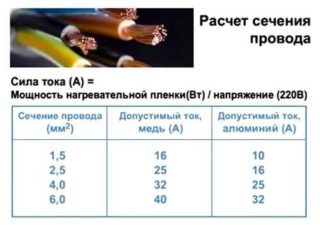An accurate calculation of the cable cross-section is necessary when arranging a home electrical network. A miscalculation will lead to buying a short or thin halter that will heat up. Doing so can cause a fire and build-up of static electricity on the surfaces of household appliances.
- What is the calculation of the cable cross-section for?
- What affects the heating of wires
- How is the power consumption calculation done?
- Features of calculating the power of hidden wiring
- How to calculate the cable cross-section by power
- Maximum power consumption
- Conductor material
- How to correctly calculate for other indicators
- By current
- By lenght
- By load
- By voltage
- By current density
- By wire marking
- How to choose a conductor cross-section
- By type of wiring
- Payments via the Internet
- Without calculators and tables
What is the calculation of cable cross-section for?

An apartment or home electrical network must be economical, safe and reliable. To prevent the effects of electricity on a person and the room itself, it is required to calculate the optimal conductor cross-section.
Lack of calculations has risks of rupture, deformation of the wiring, which will cause a short circuit or electric shock. A small cross-sectional area will increase the voltage of the wires. This will cause them to overheat.
A large cross-sectional area is safer, but more costly. Careful calculations will help ensure uninterrupted network operation and financial savings.
What affects the heating of wires
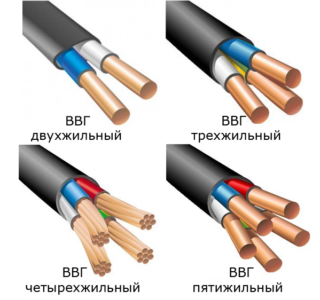
In the process of using household appliances, the wiring is very often heated. Overheating occurs due to several factors:
- Wrong choice of conductor cross-sectional area. The thicker the cores of the cable, the more current it transmits without overheating. You can find out the necessary parameters by marking the product or after measuring with a caliper.
- Inconsistency of materials of manufacture. Copper wire transfers voltage better, has a low resistance. Aluminum conductors heat up more strongly with high resistance.
- Number of lived. The single core conductor with a thick core has a high current carrying capacity. Multicore modifications are flexible, but have a lower limiting current transfer strength.
- Installation specifics. Cables are more hot when placed tightly in a pipe than when they are open.
- Isolation features. Inexpensive materials with poor-quality insulation are unstable to deformation and temperature effects.
The low electrical conductivity of aluminum wires provides for a larger cross section than copper wires.
How is the power consumption calculation done?

On the basis of the PUE, it is allowed to organize copper or aluminum wiring in an apartment and a house. Before laying it and purchasing consumables, it is advisable to calculate the optimal cable cross-section for power consumption. The user will need:
- Make a list of all the household appliances in the apartment.
- Put down its power against each unit (indicated on the label or in the instructions).
- Sum all numbers.
- Determine rare, periodic and permanent device types.
- Add up the power of constant and periodically switched on.
- Set the approximate load time and mains voltage indicator.
- With a factor of 70% (0.7), calculate the thickness of the conductor.
The power value of household appliances can be found in the table.
| Device type | Power, W |
| Electric kettle | 1000-2000 |
| Oven | 2500 |
| Electric stove | 2000-4500 |
| Refrigerator | 200-1000 |
| Dishwasher | 2000 |
| Washing machine | 2000-2500 |
| Boiler | 1100-2000 |
| A vacuum cleaner | 1500-2000 |
| Television | 70-200 |
| Iron | 2000 |
| Microwave | 800 |
| PC | 250-600 |
| Lighting | 500 |
| Mixer | 2500-4000 |
| Hair dryer | 400-1800 |
| Fan | 1000-2000 |
| Air conditioning | 1200-3000 |
The voltage value in a three-phase network is 380 V, in a single-phase network - 220 V.
Features of calculating the power of hidden wiring
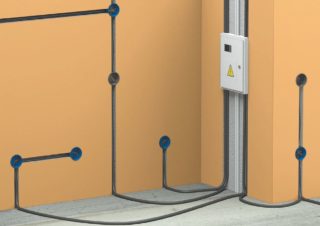
When the project specifies the possibility of laying hidden wiring, the diameter and cross-sectional parameters of the cable must be purchased with a margin. To the indicator obtained after the calculation, add 20-30%. Such calculations exclude heating of the conductor in a closed space with minimal air access.
If several conductors are laid in closed channels, the thickness of each increases by 40%. For additional protection against overheating, each product is packed in an individual corrugated pipe.
How to calculate the cable cross-section by power
To calculate the apartment wire by power indicators for a three-phase network, the formula I = P / (U * 1.73) is used, where
- P - power, W;
- U - voltage, V;
- I - current, A.
When making independent calculations, it is necessary to take into account the material of the cores, the maximum power consumption and the voltage in the network.
Maximum power consumption
For an accurate value, you need to know how much energy each device will consume. Then the indicators are summed up, and the average value is calculated. To get the full value, add another 5%.
Conductor material
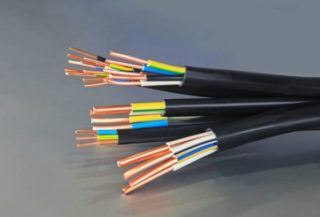
An apartment circuit is created from two types of conductors:
- Aluminum - inexpensive materials for laying networks at a height. The metal does not oxidize, but for an even distribution of the load, it is worth stopping the choice on a wire with a large cross section.
- Copper - strong, resilient, with good electrical conductivity. Provide an even supply of current to each consumer. If the house has an old switchboard or transformer, the wires are connected with a third metal.
The PUE says that the standard load of the network through which electricity passes to residential and industrial buildings is 25 A. You can choose the optimal section from the pivot table.
Table 1. Dependence of the cross-section of a copper wire on power and current
| Wire section, mm2 | Voltage 220 V | Voltage 380 V | ||
| Current, A | power, kWt | Current, A | power, kWt | |
| 1,5 | 19 | 4,2 | 16 | 10,5 |
| 2,5 | 27 | 5,9 | 25 | 16,5 |
| 4 | 38 | 8,3 | 30 | 19,8 |
| 6 | 46 | 10,1 | 40 | 26,4 |
| 10 | 70 | 15,4 | 50 | 33 |
| 16 | 85 | 18,7 | 75 | 49,5 |
| 25 | 115 | 25,3 | 90 | 59,4 |
| 35 | 135 | 29,7 | 115 | 75,9 |
| 50 | 175 | 38,5 | 145 | 95,7 |
| 70 | 215 | 47,3 | 180 | 118,8 |
| 95 | 260 | 57,2 | 220 | 145,2 |
| 120 | 300 | 66 | 260 | 171,6 |
Table 2. Dependence of the cross-section of an aluminum wire on power and current
| Wire section, mm2 | Voltage 220 V | Voltage 380 V | ||
| Current, A | power, kWt | Current, A | power, kWt | |
| 2,5 | 20 | 4,4 | 19 | 12,5 |
| 4 | 28 | 6,1 | 23 | 15,1 |
| 6 | 36 | 7,9 | 30 | 19,8 |
| 10 | 50 | 11 | 39 | 25,7 |
| 16 | 60 | 13,2 | 55 | 36,3 |
| 25 | 85 | 18,7 | 70 | 46,2 |
| 35 | 100 | 22 | 85 | 70 |
| 50 | 135 | 29,7 | 110 | 72 |
| 70 | 165 | 36,3 | 140 | 92,4 |
| 95 | 200 | 44 | 170 | 112,2 |
| 120 | 230 | 50,6 | 200 | 132,2 |
How to correctly calculate for other indicators
By current
The amount of current passing through a conductor at room temperature depends on the width, length, resistivity and temperature conditions. In apartments and houses, copper wire is most often used, therefore, when selecting a cross-section, they are guided by the PUE data.
| Section, mm2 | Current, A by type of laying | |||||
| Open | One pipe | |||||
| 2 single core | 3 single core | 4 single core | 1 two-wire | 1 three-core | ||
| 0,5 | 11 | — | — | — | — | — |
| 0,75 | 15 | — | — | — | — | — |
| 1 | 17 | 16 | 15 | 14 | 15 | 14 |
| 1,2 | 20 | 18 | 16 | 15 | 16 | 14,5 |
| 1,5 | 23 | 19 | 17 | 16 | 18 | 15 |
| 2 | 26 | 24 | 22 | 20 | 23 | 21 |
| 2,5 | 30 | 27 | 25 | 25 | 25 | 24 |
| 3 | 34 | 32 | 28 | 26 | 28 | 24 |
| 4 | 41 | 38 | 35 | 30 | 22 | 27 |
To install a specific device, it is worth clarifying its current strength and comparing the indicator with the data in the table. If there is no value, they are guided by a larger value. This prevents the cable from catching fire at maximum load.
By lenght
In the case of high current consumption, it is worth choosing a short material. Excessive length will lead to a loss in the quality of power transmission - the voltage in some sections will "jump". The dependence of the section on the distance to the feeding point is prescribed in the standard table.
| Power, W | Current, A | 1.5 mm2 | 2.5 mm2 | 4 mm2 | 6 mm2 |
| 500 | 2,5 | 100 m | 165 m | 265 m | 395 m |
| 1000 | 4.6 m | 30 m | 84 m | 135 m | 200 m |
| 1500 | 6.8 m | 33 m | 57 m | 90 m | 130 m |
| 2000 | 9 m | 25 sec | 43 m | 68 m | 100 m |
| 2500 | 11.5 m | 20 m | 34 m | 54 m | 80 m |
| 3000 | 13.5 m | 17 m | 29 m | 45 m | 66 m |
| 3500 | 16 m | 14 m | 24 m | 39 m | 56 m |
| 4000 | 18 m | — | 21 m | 34 m | 49 m |
| 4500 | 20 m | — | 19 m | 30 m | 44 m |
The value obtained during the selection must be increased by 15 cm - the amount of margin for switching by crimping, welding or soldering.
By load
A three-phase network is characterized by a triple increase in the load torque. A double load surge in symmetrical voltage mode occurs because the neutral conductor current is zero. The exact data can be found in the table.
| Voltage difference,% | Load moment over wire cross-section | |||
| 1,5 | 2,5 | 4 | 6 | |
| 1 | 108 | 180 | 288 | 432 |
| 2 | 216 | 360 | 576 | 864 |
| 3 | 324 | 540 | 864 | 1296 |
| 4 | 432 | 720 | 1152 | 1728 |
| 5 | 540 | 900 | 1440 | 2160 |
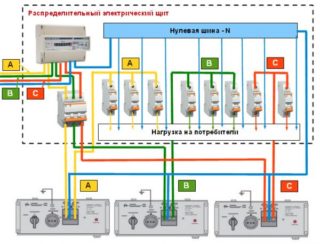
The calculation of the wire cross-section for the load provides for a simultaneity factor of 0.75 and can be carried out mathematically:
- A list of household electrical appliances is being compiled.
- The rated power is indicated on the basis of documentation or a table.
- The possibility of operating equipment at a one-time load is established.
- The correction factor for the time of use per day is calculated as a percentage of 24 hours for each of the devices.
- The power rating of the equipment is multiplied by the correction factor.
- All data are summarized.
- The value is found in the table and another 15% is added to it.
Since manufacturers indicate averages, another 5% is added.
By voltage
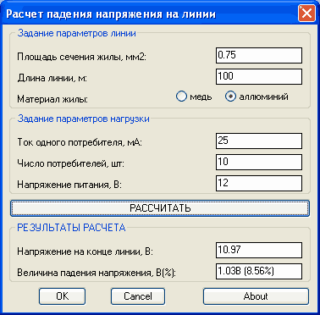
If the cable is to be laid over a long distance, the risks of voltage drop are taken into account. The indicator is influenced by:
- wire length - when increasing, the voltage drops;
- cross-sectional area - voltage drop decreases with increasing;
- resistivity of the conductor - standard size 1 mm2 / 1 m.
The voltage drop is equal to the current times the resistance. The indicator is calculated as follows:
- The current is calculated by the formula I = P / (U * cosph). The cosf value for the household power supply is 1.
- Based on the PUE tables, the current wire cross-section is established.
- The total resistance of the conductor is calculated. The formula is used Ro = ρ * l / S, where ρ is the resistivity of the material, l is the length of the conductor, S is the cross-sectional area. The total resistance value when current passes to the consumer and back increases by 2.
- The voltage drop is found according to the formula ΔU = I * R.
- The percentage of voltage drop ΔU / U is calculated.
If the result is more than 5%, a cable with a large cross-section is selected.
By current density
Copper materials with a conductive cross-section of 1 mm2 have an average current density of 6-10 A. Currents of this magnitude flow without overheating or burning of the insulation. According to the PUE, in addition to the protection of the shells, you need to add 40%.
The 6 A limit ensures that the wiring is operated without reference to time. The upper limit of 10 A indicates the permissible short-term load. With an increase in the current strength to 12 A, its density also increases, which leads to the burning of the insulation.
By wire marking
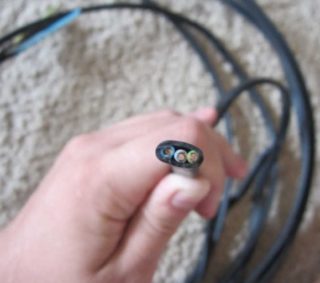
Apartment wiring is mounted using VVG-ng and VVG cables. The first is not subject to fires, it is intended for indoor, ground and outdoor work. The material is produced with 2-4 cores, each with a cross-section from 1.5 to 35 mm2.
Experts believe that a cable with a cross-section of 0.5 mm² is enough for spot lighting, 1.5 mm² for a chandelier, and 2.5 mm² for socket devices.
How to choose a conductor cross-section
In order to choose the right conductor cross-section, it is worth considering the length of the communications, the way they are arranged, the features of the machines.
By type of wiring
By location, the wiring is hidden and open. In apartments, the second option is more often installed with the laying of a copper cable in a groove. To select its section, they are guided by the data in the table.
| Power, W | Current strength, A | Copper conductor | |
| Sectional area, mm2 | Diameter, mm | ||
| 100 | 0,43 | 0,09 | 0,33 |
| 200 | 0,87 | 0,17 | 0,47 |
| 300 | 1,3 | 0,26 | 0,58 |
| 400 | 1,74 | 0,35 | 0,67 |
| 500 | 2,17 | 0,43 | 0,74 |
| 750 | 3,26 | 0,65 | 0,91 |
| 1000 | 4,35 | 0,87 | 1,05 |
| 1500 | 6,52 | 1,3 | 1,29 |
| 2000 | 8,7 | 1,74 | 1,49 |
| 2500 | 10,87 | 2,17 | 1,66 |
| 3000 | 13,04 | 2,61 | 1,82 |
| 3500 | 15,22 | 3,04 | 1,97 |
| 4000 | 17,39 | 3,48 | 2,1 |
| 4500 | 19,57 | 3,91 | 2,23 |
Payments via the Internet
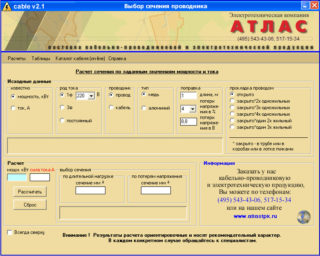
In order not to waste time on manual calculations, you can calculate the cable cross-section parameters online. In the fields of the calculator you will need to enter:
- type of current - alternating or direct;
- conductor material - copper or aluminum;
- load power - the sum of the powers of all devices thrown on 1 wire;
- rated mains voltage;
- for alternating current - power supply system, single-phase or three-phase system, power factor 1 for an apartment;
- cable laying technology - open or hidden;
- the number of load wires - 2, 3.4 with separate insulation or 2-3 in total; for a direct current system, all wires are considered, for an alternating current with one phase - zero and a phase, for an alternating current with three phases - only a phase;
- cable length in meters;
- percentage of allowable voltage drop.
The resulting value is approximate, it will need to be coordinated with professionals and the requirements of the standards.
Without calculators and tables
For the accuracy of the section selection, it is worthwhile to use theoretical and actual calculations in a comprehensive manner. The buyer needs:
- look at the cable insert for the cross-sectional data;
- measure the diameter of the core with a caliper or micrometer;
- calculate the cross-sectional area using the formula S = (z · π · d 2) / 4 (3), where S is the cross-sectional area; z is the number of cores (for a single-core wire z = 1); d - diameter.
The correct selection of the conductor cross-section will ensure the reliability and quality of the power lines in the apartment. These tables and formulas in practice help to control the work of electricians and compare their calculation results with their own.

